I forgot to mention it earlier this week, but Flipped will be on a brief hiatus during The Comics Reporter’s Holiday Interview series. I’m very flattered that Tom Spurgeon has provided a home for the columns, and I was also flattered that he asked me to participate in the series. It’s here, a lengthy chat on the craziest Osamu Tezuka manga I’ve read to date.
For your Eisner consideration
‘Tis the season for lists of the best comics and graphic novels of 2009, an event I always enjoy more as a spectator than as a provider. I would feel comfortable listing my favorite comics of the year, but some pocket of insecurity blocks me from using the word “best.” Fortunately, ‘tis also the season to nominate titles for the 2010 Will Eisner Comics Industry Awards.
As you might recall, there was some disgruntlement over the rather narrow field of manga nominees in last year’s Eisner slate. This came on after a couple of years where there was a healthy sprinkling of comics and creators from Japan throughout the roster. While complaining afterwards is always fun (it’s the peak pleasure of “Best of” season, after all), I thought it certainly couldn’t hurt to throw out some suggestions for various Eisner categories while it might still make a difference.
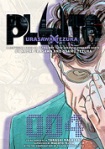
 Just looking at the aforementioned “Best of” lists, we can be reasonably certain that at least two titles are locks for some form of Eisner nomination: Naoki Urasawa’s Pluto: Urasawa x Tezuka (Viz) and Yoshihiro Tatsumi’s A Drifting Life (Drawn & Quarterly). They’re the two comics from Japan that have appeared most frequently on lists of the best comics and graphic novels of 2009. They’re fine choices and among my favorite new works from 2009, but their respective inevitability makes me disinclined to dwell on them too much, except to recommend that A Drifting Life be nominated in the Best Reality-Based Work category.
Just looking at the aforementioned “Best of” lists, we can be reasonably certain that at least two titles are locks for some form of Eisner nomination: Naoki Urasawa’s Pluto: Urasawa x Tezuka (Viz) and Yoshihiro Tatsumi’s A Drifting Life (Drawn & Quarterly). They’re the two comics from Japan that have appeared most frequently on lists of the best comics and graphic novels of 2009. They’re fine choices and among my favorite new works from 2009, but their respective inevitability makes me disinclined to dwell on them too much, except to recommend that A Drifting Life be nominated in the Best Reality-Based Work category.
 I make that suggestion because 2009 saw a whole lot of extraordinary comics from Japan, so the real estate in the Best U.S. Edition of Foreign Material – Japanese category will be costly indeed. To start, there’s Urasawa’s other series in current release, 20th Century Boys, which I actually prefer to Pluto. I’m not saying it’s a better comic point by point, but I enjoy reading it more. It may lack Pluto’s seriousness of purpose and craftsmanship, but it’s compulsively readable and friendlier. Perhaps the solution is to nominate Urasawa in the Best Writer/Artist – Drama category or to nominate Pluto in the Best New Series slate. Urasawa has popped up in a variety of categories in the past, and I see no reason for that trend to stop now.
I make that suggestion because 2009 saw a whole lot of extraordinary comics from Japan, so the real estate in the Best U.S. Edition of Foreign Material – Japanese category will be costly indeed. To start, there’s Urasawa’s other series in current release, 20th Century Boys, which I actually prefer to Pluto. I’m not saying it’s a better comic point by point, but I enjoy reading it more. It may lack Pluto’s seriousness of purpose and craftsmanship, but it’s compulsively readable and friendlier. Perhaps the solution is to nominate Urasawa in the Best Writer/Artist – Drama category or to nominate Pluto in the Best New Series slate. Urasawa has popped up in a variety of categories in the past, and I see no reason for that trend to stop now.
 Of course, I would hope that there’s room in the Best Writer/Artist roster for Takehiko Inoue, who has three series currently in English release, all from Viz: samurai epic Vagabond, available in regular and VizBig editions; shônen hoops classic Slam Dunk; and the achingly good, criminally underappreciated Real, which examines the lives of wheelchair basketball players. If the judges can’t bring themselves to give Inoue a Writer/Artist slot, I urge them in the strongest possible terms to save a space in Best U.S. Edition of Foreign Material – Japanese or Best Continuing Series for Real, because it’s one of the finest comics currently in release, magnificently drawn and faultlessly written.
Of course, I would hope that there’s room in the Best Writer/Artist roster for Takehiko Inoue, who has three series currently in English release, all from Viz: samurai epic Vagabond, available in regular and VizBig editions; shônen hoops classic Slam Dunk; and the achingly good, criminally underappreciated Real, which examines the lives of wheelchair basketball players. If the judges can’t bring themselves to give Inoue a Writer/Artist slot, I urge them in the strongest possible terms to save a space in Best U.S. Edition of Foreign Material – Japanese or Best Continuing Series for Real, because it’s one of the finest comics currently in release, magnificently drawn and faultlessly written.
 On the subject of magnificently drawn and beautifully written manga, this will be judges’ final opportunity to recognize Kaoru Mori’s breathtaking period drama, Emma (CMX). The tenth and final volume came out earlier this winter, offering a satisfying conclusion to the driving storyline and a sentimental farewell to the rich cast of supporting characters that made this series so rewarding. Intelligent, meticulously researched, emotionally resonant, and all-around glorious, a lot of people are going to miss this book terribly.
On the subject of magnificently drawn and beautifully written manga, this will be judges’ final opportunity to recognize Kaoru Mori’s breathtaking period drama, Emma (CMX). The tenth and final volume came out earlier this winter, offering a satisfying conclusion to the driving storyline and a sentimental farewell to the rich cast of supporting characters that made this series so rewarding. Intelligent, meticulously researched, emotionally resonant, and all-around glorious, a lot of people are going to miss this book terribly.

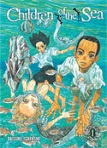 In a rather different vein, one devoid of delicacy or refinement but brimming with genius, please don’t forget Junko Mizuno’s subversive Little Fluffy Gigolo Pelu (Last Gasp). Mizuno is a household name, assuming that household name counts a hardcore comics omnivore among its residents. She should be more famous, with her inimitable aesthetic and subversive sensibilities, and Pelu could be the book that pushes her over the top. It’s a profane, hilarious look at the intersection of sex, love and obsession from the perspective of a sentient space ovary. It’s the comic equivalent of a hallucinogen mixed with an amphetamine, and it’s my favorite new manga of 2009. But I would also hope that there’s room for Daisuke Igarashi’s Children of the Sea (Viz), the first release in that publisher’s tremendously promising SigIKKI imprint of alternative manga. It’s a contemporary environmental fable with absolutely immersive artwork and subdued storytelling all around.
In a rather different vein, one devoid of delicacy or refinement but brimming with genius, please don’t forget Junko Mizuno’s subversive Little Fluffy Gigolo Pelu (Last Gasp). Mizuno is a household name, assuming that household name counts a hardcore comics omnivore among its residents. She should be more famous, with her inimitable aesthetic and subversive sensibilities, and Pelu could be the book that pushes her over the top. It’s a profane, hilarious look at the intersection of sex, love and obsession from the perspective of a sentient space ovary. It’s the comic equivalent of a hallucinogen mixed with an amphetamine, and it’s my favorite new manga of 2009. But I would also hope that there’s room for Daisuke Igarashi’s Children of the Sea (Viz), the first release in that publisher’s tremendously promising SigIKKI imprint of alternative manga. It’s a contemporary environmental fable with absolutely immersive artwork and subdued storytelling all around.
 Speaking of the SigIKKI iprint, I see nothing that would prevent anyone from nominating the SigIKKI site in the Best Anthology category. One of the great pleasures of 2009 has been the ability to read new chapters of around a dozen exciting, alternative manga titles each Thursday. Beyond the extraordinary quality of some of the comics in rotation (many of which will be likely Eisner candidates when they see print), the whole thing strikes me as a very forward-looking initiative, a smart and generous loss leader to build an audience for books with perhaps marginal commercial potential.
Speaking of the SigIKKI iprint, I see nothing that would prevent anyone from nominating the SigIKKI site in the Best Anthology category. One of the great pleasures of 2009 has been the ability to read new chapters of around a dozen exciting, alternative manga titles each Thursday. Beyond the extraordinary quality of some of the comics in rotation (many of which will be likely Eisner candidates when they see print), the whole thing strikes me as a very forward-looking initiative, a smart and generous loss leader to build an audience for books with perhaps marginal commercial potential.
 Back on the subject of taking your last chance to recognize worthy work, judges might also do something really nervy and give a slot in the Best U.S. Edition of Foreign Material – Japanese to Natsuki Takaya’s Fruits Basket (Tokyopop). Commercial success has never been a barrier to nomination in the past, and Fruits Basket is so much more than the piles and piles of money it made. It was a wrenching and lovely series throughout, and it ended with all of the grace and emotion its fans had every reason to expect. The Eisners haven’t nominated a shôjo title in this category since Fumi Yoshinaga’s Antique Bakery in 2007. (And while it’s not shôjo, nor is it explicitly for teens, keep an eye on Yoshinaga’s Ôoku from Viz for 2011. It’s off to a promising start, but I suspect it will hit its full stride next year.)
Back on the subject of taking your last chance to recognize worthy work, judges might also do something really nervy and give a slot in the Best U.S. Edition of Foreign Material – Japanese to Natsuki Takaya’s Fruits Basket (Tokyopop). Commercial success has never been a barrier to nomination in the past, and Fruits Basket is so much more than the piles and piles of money it made. It was a wrenching and lovely series throughout, and it ended with all of the grace and emotion its fans had every reason to expect. The Eisners haven’t nominated a shôjo title in this category since Fumi Yoshinaga’s Antique Bakery in 2007. (And while it’s not shôjo, nor is it explicitly for teens, keep an eye on Yoshinaga’s Ôoku from Viz for 2011. It’s off to a promising start, but I suspect it will hit its full stride next year.)
 Of course, it wouldn’t be the worst thing in the world if Fruits Basket was nominated in the Best Publication for Teens category, which manga could handily pack from top to bottom and still have partisans crying out at the injustice of some exclusion or another. I’ll limit myself to one suggestion for this category, Karuho Shiina’s Kimi ni Todoke: From Me to You (Viz). It’s a hilarious romantic comedy about an outwardly creepy but inwardly sparkly girl trying to make friends on her own terms. It seesaws smartly between laughter and tears and speaks to the odd kid out.
Of course, it wouldn’t be the worst thing in the world if Fruits Basket was nominated in the Best Publication for Teens category, which manga could handily pack from top to bottom and still have partisans crying out at the injustice of some exclusion or another. I’ll limit myself to one suggestion for this category, Karuho Shiina’s Kimi ni Todoke: From Me to You (Viz). It’s a hilarious romantic comedy about an outwardly creepy but inwardly sparkly girl trying to make friends on her own terms. It seesaws smartly between laughter and tears and speaks to the odd kid out.
 Moving down the age scale, someone really should recognize Yen Press for rescuing Kiyohiko Azuma’s Yotsuba&! from publishing limbo. It was nominated in 2008 in the Best Publication for Kids category (or whatever it was called back then), and another nomination is in order. It’s still one of the funniest, freshest comics around, following a green-haired girl as she experiences the world’s many wonders, from riding a bike to running errands. Of course, it wasn’t conceived for kids, but who cares? And if you, like me, don’t read as many comics for kids as you feel you should, you can always check out this marvelous list of the year’s best from Good Comics for Kids.
Moving down the age scale, someone really should recognize Yen Press for rescuing Kiyohiko Azuma’s Yotsuba&! from publishing limbo. It was nominated in 2008 in the Best Publication for Kids category (or whatever it was called back then), and another nomination is in order. It’s still one of the funniest, freshest comics around, following a green-haired girl as she experiences the world’s many wonders, from riding a bike to running errands. Of course, it wasn’t conceived for kids, but who cares? And if you, like me, don’t read as many comics for kids as you feel you should, you can always check out this marvelous list of the year’s best from Good Comics for Kids.
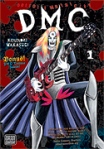
 Given that it’s so damned funny, Yotsuba&! might also sit comfortably in the Best Humor Publication category, but I have other plans there. The first involves a nomination for Kiminori Wakasugi’s hilariously distasteful Detroit Metal City (Viz), about a would-be emo-pop crooner forced to moonlight as a vile, death-metal front man. The second involves a nomination for Koji Kumeta’s dense satire, Sayonara, Zetsubou-Sensei: The Power of Negative Thinking (Del Rey). Beyond being a master class in the art and science of translation, this is a very funny book.
Given that it’s so damned funny, Yotsuba&! might also sit comfortably in the Best Humor Publication category, but I have other plans there. The first involves a nomination for Kiminori Wakasugi’s hilariously distasteful Detroit Metal City (Viz), about a would-be emo-pop crooner forced to moonlight as a vile, death-metal front man. The second involves a nomination for Koji Kumeta’s dense satire, Sayonara, Zetsubou-Sensei: The Power of Negative Thinking (Del Rey). Beyond being a master class in the art and science of translation, this is a very funny book.
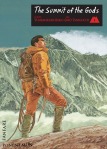 Jiro Taniguchi is a good writer, and he’s a positively magnificent illustrator, so I would recommend he be nominated as Best Penciller for his work on The Summit of the Gods (Fanfare/Ponent Mon), written by Baku Yumemakura. For reinforcement, Taniguchi sturdily wrote and gorgeously drew A Distant Neighborhood (Fanfare/Ponent Mon).
Jiro Taniguchi is a good writer, and he’s a positively magnificent illustrator, so I would recommend he be nominated as Best Penciller for his work on The Summit of the Gods (Fanfare/Ponent Mon), written by Baku Yumemakura. For reinforcement, Taniguchi sturdily wrote and gorgeously drew A Distant Neighborhood (Fanfare/Ponent Mon).
 I can’t quite bring myself to recommend Inio Asano’s What a Wonderful World! (Viz) for a major category; there’s some outstanding work contained in these two volumes of short stories, but a goodly portion is merely very good. I’d have no reservations about suggesting “A Town of Many Hills” from the first volume for the Best Short Story prize, as it shows Asano at the peak of his considerable powers.
I can’t quite bring myself to recommend Inio Asano’s What a Wonderful World! (Viz) for a major category; there’s some outstanding work contained in these two volumes of short stories, but a goodly portion is merely very good. I’d have no reservations about suggesting “A Town of Many Hills” from the first volume for the Best Short Story prize, as it shows Asano at the peak of his considerable powers.
 I’m not really worried that Taiyo Matsumoto’s GoGo Monster (Viz) will be neglected. It’s just too good. The only question is in which categories it will be nominated. To my thinking, it’s eligible for Best U.S. Edition of Foreign Material – Japanese, Best Graphic Album – Reprint Material, and Best Publication Design. Judges may want to limit that last possibility to new designs rather than stateside reproductions, but the packaging is extraordinary.
I’m not really worried that Taiyo Matsumoto’s GoGo Monster (Viz) will be neglected. It’s just too good. The only question is in which categories it will be nominated. To my thinking, it’s eligible for Best U.S. Edition of Foreign Material – Japanese, Best Graphic Album – Reprint Material, and Best Publication Design. Judges may want to limit that last possibility to new designs rather than stateside reproductions, but the packaging is extraordinary.
None of the Eisner categories will be easy to limit, but I suspect that Best Archival Collection will be particularly difficult. I’m not going to make it any easier. A year without a nomination for a work by Osamu Tezuka would just seem odd, and Vertical has been providing a valuable service (and really entertaining comics) by releasing a steady stream of Tezuka’s excellent medical melodrama Black Jack. At least some of the material in culinary classic Oishinbo (Viz), written by Tetsu Kariya and illustrated by Akira Hanasaki, is 20 years old, and all of it is lively, informative, and enriches the scope of Japanese comics available in translation and available comics in general. If it doesn’t qualify for the archival award, put it in the Best Edition of Foreign Material – Japanese. Just put it somewhere. Beyond being very, very good on strictly qualitative terms, Susumu Katsumata’s Red Snow (Drawn and Quarterly) gives readers a glimpse of a different kind of gekiaga, a category of dramatic comics for grown-ups previously defined by the aforementioned Tatsumi.
Entries for Eisner consideration are due March 8. Publishers, get cracking. Judges, get reading.
Previews review December 2009
Why just look at what’s arriving when you can look three months… into the future? Yes, it’s time to peruse the December 2009 edition of Diamond’s Previews catalog.
 New shôjo from CMX is always worth a look. This month’s offering is My Darling! Miss Bancho, written and illustrated by Mayu Fujikata. It’s a reverse-harem romantic comedy about a girl whose dreams of starting a new life go south when she realizes she’s the only female student at her new technical school. It was originally published by Hakusensha in LaLa, which has also given the world Ouran High School Host Club, Penguin Revolution, Venus in Love, and Vampire Knight, among others. That would make the magazine what one might call a “reliable source.” (Page 119)
New shôjo from CMX is always worth a look. This month’s offering is My Darling! Miss Bancho, written and illustrated by Mayu Fujikata. It’s a reverse-harem romantic comedy about a girl whose dreams of starting a new life go south when she realizes she’s the only female student at her new technical school. It was originally published by Hakusensha in LaLa, which has also given the world Ouran High School Host Club, Penguin Revolution, Venus in Love, and Vampire Knight, among others. That would make the magazine what one might call a “reliable source.” (Page 119)
On the ongoing front, we have the second volume of Asuka Izumi’s adorable The Lizard Prince and the 15th volume of Yasuko Aokie’s mad classic, From Eroica with Love. (Page 121)
CLAMP fans, rejoice! Not only is Del Rey publishing CLAMP in America, a richly detailed history of the manga-making super-group, it’s being written by the inimitable Shaenon Garrity. Del Rey also promises “a detailed guide to their work; a rare behind-the-scenes look at their creative process, together and separately; CLAMP’s role in the explosion of manga in America; interviews, and more.” Sounds like an essential for CLAMP fans, Garrity fans, and manga watchers in general. So that’s basically everyone, right? (Page 224)
 I loved Raina Telgemeier’s Smile mini-comics, so I’m thrilled that they’ve turned into a new graphic novel to be published by Graphix. Publishers Weekly calls it a “charming addition to the body of young adult literature that focuses on the trials and tribulations of the slightly nerdy girl.” Graphix doesn’t seem to have added it to its web site, so I’ll point you toward the Barnes & Noble listing. (Page 236)
I loved Raina Telgemeier’s Smile mini-comics, so I’m thrilled that they’ve turned into a new graphic novel to be published by Graphix. Publishers Weekly calls it a “charming addition to the body of young adult literature that focuses on the trials and tribulations of the slightly nerdy girl.” Graphix doesn’t seem to have added it to its web site, so I’ll point you toward the Barnes & Noble listing. (Page 236)
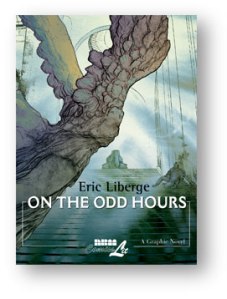 NBM has been translating a series of graphic novels created in conjunction with the Louvre museum in Paris. I loved the first, Nicolas De Crécy’s Glacial Period, and thought the second, Marc-Antoine Mathieu’s The Museum Vaults: Excerpts from the Journal of an Expert, was intriguing but problematic. But honestly, I’ll buy any of these books that NBM chooses to publish. Next up is Eric Liberge’s On the Odd Hours, about “a deaf night watchman who somehow manages to communicate with the souls of these ethereal and timeless works of art.” (Page 256)
NBM has been translating a series of graphic novels created in conjunction with the Louvre museum in Paris. I loved the first, Nicolas De Crécy’s Glacial Period, and thought the second, Marc-Antoine Mathieu’s The Museum Vaults: Excerpts from the Journal of an Expert, was intriguing but problematic. But honestly, I’ll buy any of these books that NBM chooses to publish. Next up is Eric Liberge’s On the Odd Hours, about “a deaf night watchman who somehow manages to communicate with the souls of these ethereal and timeless works of art.” (Page 256)
Oni offers a softcover edition of Scott Chantler’s terrific historical adventure, Northwest Passage. I’ve already reviewed the hell out of this series, so I’ll link instead of repeating myself. (Page 257)
While I don’t usually point out books that are being offered again without any significant format changes, I have to make an exception for Osamu Tezuka’s demented bit of gekiga brilliance, MW (Vertical). If you missed it the first time around, now’s your chance. (Page 272)
 Viz sent me a preview copy of Natsume Ono’s not simple, and I’m even more convinced that 2010 will be the year she explodes in stateside critical (and hopefully consumer) consciousness. It’s an amazing book. This edition of Previews brings the happy news that Ono’s Ristorante Paradiso will soon be in our hands (if you consider three months soon). It’s about family secrets and a restaurant in Rome staffed by hunky men of a certain age. I can’t wait. (Page 277) You can check out Ono’s splendid House of Five Leaves on Viz’s SIGIKKI site.
Viz sent me a preview copy of Natsume Ono’s not simple, and I’m even more convinced that 2010 will be the year she explodes in stateside critical (and hopefully consumer) consciousness. It’s an amazing book. This edition of Previews brings the happy news that Ono’s Ristorante Paradiso will soon be in our hands (if you consider three months soon). It’s about family secrets and a restaurant in Rome staffed by hunky men of a certain age. I can’t wait. (Page 277) You can check out Ono’s splendid House of Five Leaves on Viz’s SIGIKKI site.
Other noteworthy Signature arrivals include the fourth volume of Detroit Metal City and the eighth and final volume of Pluto. (Page 277)
And speaking of Viz’s online initiatives, a Shonen Sunday title sees print. It’s shôjo superstar Yuu Watase’s shônen debut, Arata: The Legend. (Page 280)
2009 Great Manga Gift Guide
With Black Friday just around the corner, you may be trying to think up gift ideas for greed season, and some people on your list may be open to receiving the gift of manga. Here are some possibilities for your consideration. I stress that friends don’t give friends comics unless that friend has expressed an interest in receiving them. If friends insist on doing that, they at least keep the receipt.
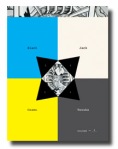 For the House fan in your life: Osamu Tezuka’s Black Jack (Vertical). Decades before Hugh Laurie’s fictional physician was saving lives and alienating people, Tezuka’s outlaw surgeon was wrestling with bizarre maladies and guaranteeing that just about nobody liked him any better for it. You can pick up any volume of this series and not worry about being lost, since it’s all largely episodic. If you know someone with a taste for the medically gruesome and interpersonally abrasive, look no further.
For the House fan in your life: Osamu Tezuka’s Black Jack (Vertical). Decades before Hugh Laurie’s fictional physician was saving lives and alienating people, Tezuka’s outlaw surgeon was wrestling with bizarre maladies and guaranteeing that just about nobody liked him any better for it. You can pick up any volume of this series and not worry about being lost, since it’s all largely episodic. If you know someone with a taste for the medically gruesome and interpersonally abrasive, look no further.
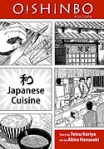 For the foodie in your life: Oishinbo (Viz), written by Tetsu Kariya and illustrated by Hanasaki Akira. Aside from its microscopic attention to Japanese food and drink, this series lets you subdivide the recipient’s interests even further. Do they tipple? Try the Sake volume. Do they hold forth on buying locally and sustainably grown produce? There’s a volume for that. When you ask what they want for lunch, is their answer always “Sushi”? Do they blanch at the idea of a low-carbohydrate diet? Voila! As with Black Jack, there’s no real order to any of these volumes, so you can pick at random.
For the foodie in your life: Oishinbo (Viz), written by Tetsu Kariya and illustrated by Hanasaki Akira. Aside from its microscopic attention to Japanese food and drink, this series lets you subdivide the recipient’s interests even further. Do they tipple? Try the Sake volume. Do they hold forth on buying locally and sustainably grown produce? There’s a volume for that. When you ask what they want for lunch, is their answer always “Sushi”? Do they blanch at the idea of a low-carbohydrate diet? Voila! As with Black Jack, there’s no real order to any of these volumes, so you can pick at random.
 For the comic strip fan in your life: Kiyohiko Azuma’s Azumanga Daioh (Yen Press). I think I recommended this in a previous gift guide, but it’s still awesome, and Yen Press is coming out with a freshened translation and production in December, so I think I’m allowed to repeat myself. This massive tome collects Azuma’s very funny strips about a group of classmates making their way through high school, and it’s a great mix of the recognizable and the absurd.
For the comic strip fan in your life: Kiyohiko Azuma’s Azumanga Daioh (Yen Press). I think I recommended this in a previous gift guide, but it’s still awesome, and Yen Press is coming out with a freshened translation and production in December, so I think I’m allowed to repeat myself. This massive tome collects Azuma’s very funny strips about a group of classmates making their way through high school, and it’s a great mix of the recognizable and the absurd.
 For the autobiography buff/young artist/cultural historian in your life: Yoshihiro Tatsumi’s A Drifting Life (Drawn & Quarterly). Tatsumi was one of the progenitors of gritty, grown-up comics in Japan, and the story of his evolution as an artist (and the associated evolution of comics publishing in Japan) is fascinating. For bonus points, Tatsumi opens a window on the economic and cultural evolution of postwar Japan as a whole.
For the autobiography buff/young artist/cultural historian in your life: Yoshihiro Tatsumi’s A Drifting Life (Drawn & Quarterly). Tatsumi was one of the progenitors of gritty, grown-up comics in Japan, and the story of his evolution as an artist (and the associated evolution of comics publishing in Japan) is fascinating. For bonus points, Tatsumi opens a window on the economic and cultural evolution of postwar Japan as a whole.
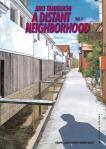 For the fan of films in limited release in your life: Jiro Taniguchi’s A Distant Neighborhood (Fanfare/Ponent Mon). So you’re thinking of buying a graphic novel for someone you know who likes to read but isn’t entirely familiar with the whole “words and pictures” category. You know that Asterios Polyp is brilliant, but it’s so dense with visual reference that the recipient might not make it past the title page. Stitches is great, but it’s non-fiction and a big downer. But you’re determined. So why not try this beautifully drawn, undemanding tale of a middle-aged guy who gets the chance to relive his adolescence? It’s flipped, so there’s no barrier there, and the story should be very familiar from a number of similar examples. It’s smart but not too literary, it’s only two volumes long but still hefty enough to count as a decent gift, and the publisher deserves your money.
For the fan of films in limited release in your life: Jiro Taniguchi’s A Distant Neighborhood (Fanfare/Ponent Mon). So you’re thinking of buying a graphic novel for someone you know who likes to read but isn’t entirely familiar with the whole “words and pictures” category. You know that Asterios Polyp is brilliant, but it’s so dense with visual reference that the recipient might not make it past the title page. Stitches is great, but it’s non-fiction and a big downer. But you’re determined. So why not try this beautifully drawn, undemanding tale of a middle-aged guy who gets the chance to relive his adolescence? It’s flipped, so there’s no barrier there, and the story should be very familiar from a number of similar examples. It’s smart but not too literary, it’s only two volumes long but still hefty enough to count as a decent gift, and the publisher deserves your money.
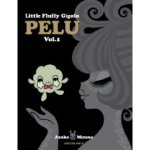 For the freak in your life: Junko Mizuno’s Little Fluffy Gigolo Pelu (Last Gasp). Do you have a friend who’s forlornly waiting for the next installment of Prison Pit? Do you want to help them pass the time? Then really, anything by Mizuno qualifies for recommendation, but Pelu is her newest available-in-English work. I don’t know if this book is remotely appropriate for anyone not wholly conversant in alternative comics, but man, how could such people not love it? I certainly do. I think it’s my favorite comic of 2009.
For the freak in your life: Junko Mizuno’s Little Fluffy Gigolo Pelu (Last Gasp). Do you have a friend who’s forlornly waiting for the next installment of Prison Pit? Do you want to help them pass the time? Then really, anything by Mizuno qualifies for recommendation, but Pelu is her newest available-in-English work. I don’t know if this book is remotely appropriate for anyone not wholly conversant in alternative comics, but man, how could such people not love it? I certainly do. I think it’s my favorite comic of 2009.
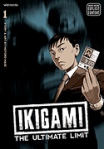 For the Death Note fan in your life: Motoro Mase’s Ikigami: The Ultimate Limit (Viz). In her review of the series, Johanna Draper Carlson astutely noted the crossover potential between this series and the shônen mega-hit. Death Note has been over for a while, and many members of its audience may have reached the recommended age for this largely winning tale of government-sponsored murder. Try and keep it out of the hands of Glenn Beck fans, though, as they’ll turn it into a book of prophecy.
For the Death Note fan in your life: Motoro Mase’s Ikigami: The Ultimate Limit (Viz). In her review of the series, Johanna Draper Carlson astutely noted the crossover potential between this series and the shônen mega-hit. Death Note has been over for a while, and many members of its audience may have reached the recommended age for this largely winning tale of government-sponsored murder. Try and keep it out of the hands of Glenn Beck fans, though, as they’ll turn it into a book of prophecy.
 For the environmentalist in your life: Daisuke Igarashi’s Children of the Sea (Viz). Have you ever noticed how some pro-nature stories can be really preachy and shrill and have next to no attractive drawings in them? Do you know of someone who enjoys tales with this kind of message and want to support them in their interests, but you’re still scarred by Captain Planet and don’t know where to turn? Look no further than Igarashi’s gorgeous, seaside fable.
For the environmentalist in your life: Daisuke Igarashi’s Children of the Sea (Viz). Have you ever noticed how some pro-nature stories can be really preachy and shrill and have next to no attractive drawings in them? Do you know of someone who enjoys tales with this kind of message and want to support them in their interests, but you’re still scarred by Captain Planet and don’t know where to turn? Look no further than Igarashi’s gorgeous, seaside fable.
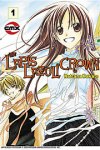 For the young fan of romantic fantasy in your life: Natsune Kawase’s The Lapis Lazuli Crown (CMX). If I had a teen-aged daughter (or son), I’d absolutely support them in just about whatever they chose to read. I’d probably voice my opinion about Black Bird, but I wouldn’t stop them from reading it. And my expression of that opinion might possibly spoil their fun in reading Black Bird, but I certainly couldn’t be held responsible for their overreaction to harmless, well-intended remarks that are entirely within my rights to state. And while they could spend their allowance on anything they wanted, they’d find this two-volume charmer in their stockings.
For the young fan of romantic fantasy in your life: Natsune Kawase’s The Lapis Lazuli Crown (CMX). If I had a teen-aged daughter (or son), I’d absolutely support them in just about whatever they chose to read. I’d probably voice my opinion about Black Bird, but I wouldn’t stop them from reading it. And my expression of that opinion might possibly spoil their fun in reading Black Bird, but I certainly couldn’t be held responsible for their overreaction to harmless, well-intended remarks that are entirely within my rights to state. And while they could spend their allowance on anything they wanted, they’d find this two-volume charmer in their stockings.
 For the hardcore Japanophile in your life: Koji Kumeta’s Sayonara, Zetsubou-Sensei (Del Rey).This is one of the densest licensed comics from Japan you’re likely to find on a bookstore shelf. It’s packed with cultural references, scrupulously annotated in extensive end notes. It’s also very, very funny. I only get about a third of the jokes, and I still think it’s hilarious. Plus, I enjoy reading the annotations, so it’s really like getting two books in one. If you know someone who loves, loves, loves Japan and is still willing to giggle at its foibles, this is the gift for them.
For the hardcore Japanophile in your life: Koji Kumeta’s Sayonara, Zetsubou-Sensei (Del Rey).This is one of the densest licensed comics from Japan you’re likely to find on a bookstore shelf. It’s packed with cultural references, scrupulously annotated in extensive end notes. It’s also very, very funny. I only get about a third of the jokes, and I still think it’s hilarious. Plus, I enjoy reading the annotations, so it’s really like getting two books in one. If you know someone who loves, loves, loves Japan and is still willing to giggle at its foibles, this is the gift for them.
Over at Okazu, Erica Friedman is tracking the various gift guides that will be unleashed upon an unsuspecting world over the next week or so.
Upcoming 11/18/2009
Chris Mautner published an appreciative primer on the great Osamu Tezuka over at Robot 6, and it’s nicely timed. This week’s ComicList offers new volumes of one of Tezuka’s enduring classics and a series based on another of his icons.
Vertical keeps the medical madness coming with the eighth volume of Tezuka’s Black Jack. Mautner notes that the comic is “not for the squeamish, and like Astro Boy it’s very episodic, with Jack pulling off one fantastic operation after another. Those who can handle the occasionally bit of surgically sliced organs and flesh will find this to be a worth their time however.” I tend to fall into the squeamish category, and I find Black Jack to be a continuing source of delight, so take that for whatever it’s worth.
The very talented Naoki (Monster, 20th Century Boys) Urasawa’s re-imagining of Tezuka’s Astro Boy classic, “The Greatest Robot on Earth,” continues in the sixth volume of Pluto. It’s a nifty blend of science fiction and murder mystery, and it’s my second-favorite Urasawa series currently being published by Viz.
Of course, it’s not all Tezuka this week. There’s also Oishinbo: The Joy of Rice, written by Tetsu Kariya and illustrated by Akira Hanasaki. I’ve really been looking forward to this volume, since I’ve never been able to consistently cook rice well, and I’m hoping it has some good advice mixed in with the toxic father-son posturing. Even if it doesn’t help me with my rice issues, I’m sure I’ll enjoy reading it.
Speaking of things I’ve been enjoying, it’s nice to be able to get in on the ground floor of Yellow Tanabe’s Kekkeishi over at Viz’s Shonen Sunday site. The print version of the series is up to its 19th volume. The Shonen Sunday site has added some other fun series like Yakitate!! Japan (over-the-top bread-baking battles) and Case Closed (teen sleuth trapped in the body of a little kid).
The cheap among us will rejoice at the arrival of the softcover version of Rick Geary’s Treasury of XXth Century Murder: Famous Players, the Mysterious Death of William Desmond Taylor. I read a prose version of the story a long time ago, so it will be interesting to see Geary’s telling. Of course, it’s always interesting to see Geary’s telling of anything.
Previews review November 2009
There aren’t very many debuts in the November 2009 Previews catalog, but there are plenty of new volumes of excellent ongoing series. Let’s start with the new arrivals, though:
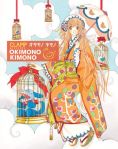 Dark Horse releases Okimono Kimoni, written and illustrated by Mokona with assistance from the rest of CLAMP. “a fun and lavishly illustrated book full of drawings and illustrations, interviews (including an interview with Ami of the J-pop duo Puffy AmiYumi!), and even short manga stories from the CLAMP artists.” So that’s your “eye-popping-ly pretty” alert for the month. (Page 43.)
Dark Horse releases Okimono Kimoni, written and illustrated by Mokona with assistance from the rest of CLAMP. “a fun and lavishly illustrated book full of drawings and illustrations, interviews (including an interview with Ami of the J-pop duo Puffy AmiYumi!), and even short manga stories from the CLAMP artists.” So that’s your “eye-popping-ly pretty” alert for the month. (Page 43.)
 I like Greek Mythology, and I thought George O’Connor’s Journey Into Mohawk Country had a lot of strong points. So I’ll definitely give O’Connor’s Olympians Volume 1: Zeus, King of the Gods (First Second) a look. “In OLYMPIANS, O’Connor draws from primary documents to reconstruct and retell classic Greek myths. But these stories aren’t sedate, scholarly works. They’re action-packed, fast-paced, high-drama adventures, with monsters, romance, and not a few huge explosions.” (Page 232.)
I like Greek Mythology, and I thought George O’Connor’s Journey Into Mohawk Country had a lot of strong points. So I’ll definitely give O’Connor’s Olympians Volume 1: Zeus, King of the Gods (First Second) a look. “In OLYMPIANS, O’Connor draws from primary documents to reconstruct and retell classic Greek myths. But these stories aren’t sedate, scholarly works. They’re action-packed, fast-paced, high-drama adventures, with monsters, romance, and not a few huge explosions.” (Page 232.)
 Alice in the Country of Hearts (Tokyopop), written by QuinRose and illustrated by Hoshino Soumei (Tokyopop) is triggering my “weird but crack-y” sensors: “Alice, who has fallen asleep in her garden, wakes up to find a white rabbit wearing clothes?! The rabbit forcefully drags Alice into the rabbit hole, where he turns into a young man with rabbit ears and leads her into a frightful world where the fairytale-like citizens wield dangerous weapons for an insidious cause… Unable to return home, will she be able to find happiness in a world full of danger and beautiful young men?” (Page 263.)
Alice in the Country of Hearts (Tokyopop), written by QuinRose and illustrated by Hoshino Soumei (Tokyopop) is triggering my “weird but crack-y” sensors: “Alice, who has fallen asleep in her garden, wakes up to find a white rabbit wearing clothes?! The rabbit forcefully drags Alice into the rabbit hole, where he turns into a young man with rabbit ears and leads her into a frightful world where the fairytale-like citizens wield dangerous weapons for an insidious cause… Unable to return home, will she be able to find happiness in a world full of danger and beautiful young men?” (Page 263.)
 I can’t say that Mohiro Kitoh’s Bokurano: Ours is my favorite title in Viz’s SIGIKKI initiative, or even in the top five, but I’m always glad to see these titles see print, since it reassures me that the ones I really enjoy will follow sooner or later. “One summer, fifteen kids innocently wander into a nearby seaside cave. There they meet a strange man who invites them to play an exciting new video game. This game, he explains, pits one lone giant robot against a horde of alien invaders. To play the game, all they have to do is sign a simple contract. The game stops being fun when the kids find out the true purpose of their pact.” (Page 273.)
I can’t say that Mohiro Kitoh’s Bokurano: Ours is my favorite title in Viz’s SIGIKKI initiative, or even in the top five, but I’m always glad to see these titles see print, since it reassures me that the ones I really enjoy will follow sooner or later. “One summer, fifteen kids innocently wander into a nearby seaside cave. There they meet a strange man who invites them to play an exciting new video game. This game, he explains, pits one lone giant robot against a horde of alien invaders. To play the game, all they have to do is sign a simple contract. The game stops being fun when the kids find out the true purpose of their pact.” (Page 273.)
 And now for the new volumes and new editions:
And now for the new volumes and new editions:
Birthday book: Tekkoninkreet
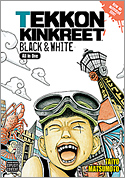 The Comics Reporter notes that it’s Taiyo Matsumoto’s birthday. Matsumoto’s GoGo Monster won’t be available for a couple of weeks, and it’s certainly on my must-buy list, but I can happily recommend his Tekkonkinkreet: Black and White to tide you over. It’s a gorgeous, absorbing book that I like even more now than I did when I first reviewed it. (The animated movie is a snooze, to be honest, but the book is a joy.) The manga won the 2008 Eisner Award for Best U.S. Edition of International Material – Japan over some very stiff competition, and it’s a legitimate win. I’d have been equally happy if Osamu Tezuka’s MW or Fumiyo Kouno’s Town of Evening Calm, Country of Cherry Blossoms had taken the price, but I think that just illustrates how good Tekkonkinkreet is that it can sit comfortably in company with those excellent, excellent comics.
The Comics Reporter notes that it’s Taiyo Matsumoto’s birthday. Matsumoto’s GoGo Monster won’t be available for a couple of weeks, and it’s certainly on my must-buy list, but I can happily recommend his Tekkonkinkreet: Black and White to tide you over. It’s a gorgeous, absorbing book that I like even more now than I did when I first reviewed it. (The animated movie is a snooze, to be honest, but the book is a joy.) The manga won the 2008 Eisner Award for Best U.S. Edition of International Material – Japan over some very stiff competition, and it’s a legitimate win. I’d have been equally happy if Osamu Tezuka’s MW or Fumiyo Kouno’s Town of Evening Calm, Country of Cherry Blossoms had taken the price, but I think that just illustrates how good Tekkonkinkreet is that it can sit comfortably in company with those excellent, excellent comics.
Vertical holdings
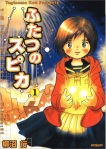

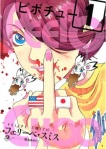
This week’s Flipped consists basically of me asking Ed Chavez a few questions about Vertical’s new licenses and then getting out of his way. This is one of my favorite ways to assemble a column, partly because it’s easy, but mostly because Ed is such an enthusiastic, well-informed manga omnivore that the results are bound to be an order of magnitude more interesting than my usual blather. (Ed also makes really good use of the conversation on Twitter, so do follow him.)
I have to say that I really admire Vertical for this slate of licenses, just as I admire other publishers who try and expand the boundaries of translated manga. Just glancing through the current Previews, I saw strong-sounding new titles and ongoing series in this loosely defined category, and it made me happy. I also went to Barnes & Noble this weekend and I could have easily spent a lot of money on manga designed to appeal to a mature audience (and I did spend a fair amount on just that kind of manga).
Admittedly, I could have spent a lot more on manga aimed at kids and teens (a lot of which is terrifically entertaining), but meaty, mature work is out there, it’s gaining in retail presence (if slowly), and more is on the way. I mean, I can find these titles on the shelves of a chain bookstore in West Virginia. That’s got to mean something, right? So if you like these kinds of titles and want to see more of them, chat them up in whatever venues are available to you, and support them with your dollars.
Meanwhile, up at Javits
I’ll get into Vertical’s announcements from the New York Anime Festival at a later date (Monday, to be precise), but I did want to highlight some of the other on-deck properties that caught my eye. (Deb Aoki has the full list at About.Com.)
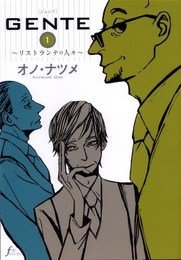 I’m finding myself increasingly taken with Natsume Ono’s House of Five Leaves with each new chapter that Viz posts, so Ono’s Gente will definitely be on my radar. I don’t really think older Italian men in aprons, at least of the kind who might appear in manga for grown-ups, need any help looking sexy, but that might just be me. It’s a follow-up to Ono’s Ristorante Paradiso, which Viz has scheduled for release in March 2010. Gente is due in July 2010.
I’m finding myself increasingly taken with Natsume Ono’s House of Five Leaves with each new chapter that Viz posts, so Ono’s Gente will definitely be on my radar. I don’t really think older Italian men in aprons, at least of the kind who might appear in manga for grown-ups, need any help looking sexy, but that might just be me. It’s a follow-up to Ono’s Ristorante Paradiso, which Viz has scheduled for release in March 2010. Gente is due in July 2010.
My desire to read about ass-kicking fictional librarians has often left me disappointed, but I remain optimist enough to give Hiro Arikawa and Kiiro Yumi’s Library Wars: Love and War a try. It’s due in June 2010.
On the Del Rey front, I liked Kitchen Princess a lot, but I liked it mostly for Miyuki Kobayashi’s surprisingly moody writing rather than Natsumi Ando’s cute but generic art. That said, I’ll certainly give Arisa a try, even though it’s about identical twins who meet later in life, and I’m still gun-shy on that subject after the clinically insane second volume of Papillon.
Bonus points to Del Rey for publishing the rest of Hiro Mashima’s Rave Master after Kodansha pulled the license from Tokyopop three volumes before the end.
Tokyopop has certainly published an awful lot of Natsuki Takaya’s manga, and that will continue with Songs and Laughter. In spite of (or maybe because of) my love for Fruits Basket, I’ve been hesitant to pick up other translated work by the creator, fearing disappointment. Can anyone recommend a title in this category?
And there was much rejoicing

Word comes via Brigid Alverson on Twitter that Vertical has acquired the license for Chi’s Sweet Home. Can I pre-order it yet? Also, Vertical earns the distinction of being the first publisher to fulfill one of my license requests. I should come up with some kind of fabulous prize for them, aside from the run-of-the-mill eternal gratitude.






